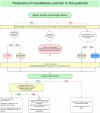A Narrative Review of Invasive Candidiasis in the Intensive Care Unit
- PMID: 39748830
- PMCID: PMC11693998
- DOI: 10.1177/29768675241304684
A Narrative Review of Invasive Candidiasis in the Intensive Care Unit
Abstract
Candida species is the most common cause of invasive fungal infection in the critically ill population admitted to the intensive care unit (ICU). Numerous risk factors for developing invasive candidiasis (IC) have been identified, and some, like the breach of protective barriers, abound within the ICU. Given that IC carries a significant mortality, morbidity, and healthcare cost burden, early diagnosis and treatment have become an essential topic of discussion. Several expert panels and task forces have been established to provide clear guidance on the management of IC. Unfortunately, IC remains a diagnostic and therapeutic challenge attributable to the changing fungal ecology of Candida species and the emergence of multidrug-resistant strains. This narrative review will focus on the following: (1) the incidence, outcomes, and changing epidemiology of IC globally; (2) the risk factors for developing IC; (3) IC risk stratification tools and their appropriate use; (4) diagnosis of IC; and (5) therapeutic agents and regimens.
Keywords: Intensive care unit; antifungal therapy; critical care; infection; invasive candidiasis; medicine; sepsis.
Plain language summary
A review of severe Candida infection in patients admitted to the Intensive Care Unit Plain Language Summary: Candida infections are the most common type of serious fungal infections that affect patients in Intensive Care Units (ICUs). There are many known risk factors for developing these infections, especially in ICU patients who often experience situations like damage to protective barriers in the body. Since these infections can lead to death, serious illness, and higher healthcare costs, it’s important to diagnose and treat them as early as possible. However, diagnosing and treating invasive Candida infections is still very difficult. This is because the types of Candida fungi are changing, and some strains are becoming resistant to multiple antifungal medications. The goal of this review is to help improve understanding and management of these serious infections in ICU settings.
© The Author(s) 2024.
Conflict of interest statement
The authors declared the following potential conflicts of interest with respect to the research, authorship, and/or publication of this article: IM-L has received speaking and advisory board fees from Merck and Gilead Sciences.
Figures
References
Publication types
LinkOut - more resources
Full Text Sources


